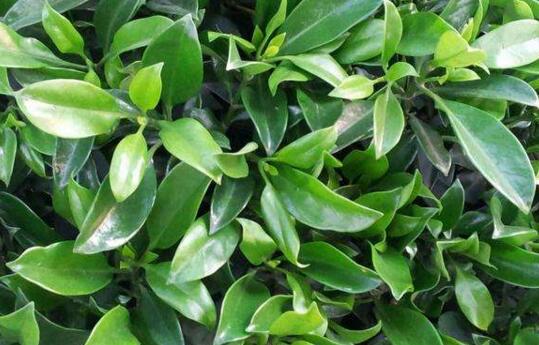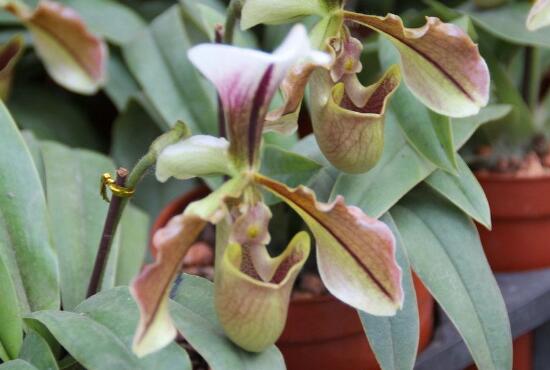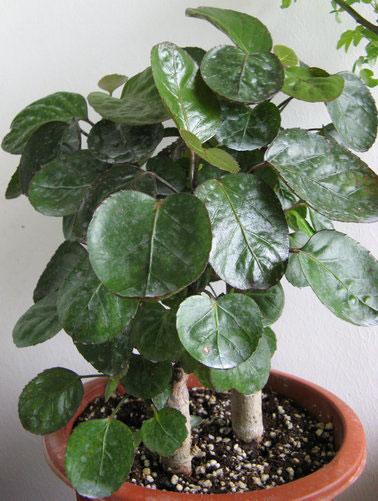How do African jasmine lose its leaves? 6 reasons are that the culprit / four measures can improve the phenomenon of falling leaves.
We know that the efficacy and function of African jasmine is mainly to watch, but sometimes people watch its beautiful leaves, but if the phenomenon of leaf loss occurs, the ornamental value will be greatly reduced, then how to do African jasmine leaves? Let's take a look at the specific reasons and solutions.
Why did African jasmine lose its leaves?
1. Caused by turning over the soil and changing the basin
In the culture method of African jasmine, we emphasize that the soil will be changed every 1-2 years, and in the process of changing the basin, African jasmine will be suitable for seedlings, so that shortly after changing the pot, the roots can not absorb enough water, resulting in the loss of some leaves.

2. The soil alkalinity is too high.
The soil in the northern region is usually alkaline, and it is customary to use alkaline tap water when watering, so it will slowly lead to excessive alkalinity of the soil, resulting in African jasmine unable to adapt to this environment, resulting in poor growth and the earliest leaf fall.
3. Watering problem
Watering too much or too little will cause African jasmine to lose its leaves. Because too little watering the root can not absorb enough water, and too much watering will cause root rot, it will also affect the root absorption of water, the result of insufficient water is the fall of leaves.
4. Climatic reasons
Many people like to keep African jasmine outdoors or on the balcony, but when the temperature drops suddenly in autumn, if it is not moved to a hotter room in time, it may cause the leaves to freeze and cause the leaves to fall early.
5. The light is too dark
African jasmine is a light-loving plant, if its environment is always dark, the leaves will lose green, yellowing and fall because of the lack of photosynthesis.
6. Strong winds attack
Although the cultivation of African jasmine, to make the environment well ventilated, but if it is at the forefront of the wind, it is always blown by the strong wind, even if the strong plant, the leaves will be blown off, so it is very normal to lose the leaves.
What if African jasmine loses its leaves?
1. Rational watering
When it is found that the leaves fall behind, the watering method should be adjusted in time, but first let African jasmine dry for a period of time, and then appropriate amount of water, watering until thoroughly, to avoid waterlogging.
2. Watering alum and fertilizing water
Alum fertilizer water is a slightly acidic fertilizer, it can improve the acidity and basicity of the soil, if the alkalinity is too high to cause African jasmine to lose leaves, you can add alum fertilizer water when watering, it can make the irrigated soil slightly acidic.
3. Make up for the light with scattered light
If African jasmine is raised in a dark place, fluorescent lamps should be used to provide enough light to African jasmine, so that the phenomenon of leaf loss can be alleviated.
4. Keep warm and avoid being attacked by strong winds
African jasmine planted on the balcony or in the tuyere should be moved to a cool place with moderate temperature when the climate change is large or there is a strong wind to avoid frostbite of the leaves caused by too low temperature.
The reason why African jasmine loses its leaves, what if African jasmine loses its leaves?
African jasmine is one of the common plants cultivated at home. Its branches and leaves are bright and luxuriant, giving people a vibrant breath. However, African jasmine is easy to lose its leaves if it is not cultivated properly, and many breeders are often at a loss about it. So what is the reason why African jasmine has lost its leaves? What if African jasmine loses its leaves? The editor will give you an answer today.
The reason for the loss of leaves of African Jasmine
The loss of leaves of African jasmine is caused by environmental factors, diseases and insect pests and so on. Understanding its growth habits is very important for the care of African jasmine.
1. Change the soil: the potted soil of African jasmine has to be changed every one to two years. After changing the soil, the original root system cannot bear the water consumption of the upper leaves, so the plant must abandon some of the evaporated leaves. It is also possible that the new soil lacks certain trace elements.
2. Too much or too little watering: too much or too little watering will affect the growth of African jasmine, thus causing the leaves of African jasmine to turn yellow and fall off. When the basin soil is too dry, the root water supply is insufficient to meet the needs of the plant, so that the leaves fall off due to lack of water; if the basin soil is too wet, it will affect the respiration of the root system, and seriously cause the rotten roots of the plant, and the leaves will wither if the nutrients are not supplied.
3, the temperature is too low: African jasmine is a tropical plant, which needs a higher growth temperature. When the temperature is lower than 5 degrees Celsius, it will stop growing and the leaves are easy to fall.
4, too little sunlight: African jasmine likes the sun, but avoids strong light, and requires sufficient scattered light when growing, which is suitable for being placed near the window, and should not be too dark, otherwise it will cause the leaves to lose green and yellowing or fall off.
5. Diseases and insect pests: improper maintenance of African jasmine will also cause insect pests and diseases, and some diseases and insect pests will also cause African jasmine leaves to turn yellow or fall off, so attention should be paid to spray control.
What if African jasmine loses its leaves?
1. Water control was carried out before May Day after the beginning of spring to dry African jasmine plants for a period of time.
2. After May Day, the plant was first heavily truncated, leaving 2-3 bud holes in the base of the surrounding branches, all the rest were cut off, and none of the leaves were left.
3. Immediately change the basin after a short cut, apply sufficient bottom fertilizer, and then fully water it many times, and do not water until a large number of new buds appear.
4. keep it in a cool and ventilated place, pay attention to observation at this time, prevent insects and diseases, and protect buds are very important.
5. after the buds increase gradually, pay attention to the planned choice and grow according to the expected plant type. at the same time, the dry branches should be cut off at any time.
6. 3 months after truncation, the sun should be seen gradually, and the moisture should be sufficient, but it should not be waterlogged, so pay attention to maintenance.
This is the reason why African jasmine lost its leaves and how to do it. African jasmine requires loose and fertile soil, good drainage, and likes an environment with high humidity, good ventilation and plenty of sunshine. When it is found that African jasmine leaves, it should be placed in a good environment, and pay attention to its soil moisture, while preventing the harm of diseases and insect pests.
What about African jasmine? what's the reason for the loss of leaves?
African jasmine is a kind of plant that is not difficult to feed. The most beautiful place of African jasmine is its leaves, but it will lose its leaves in the process of maintenance, which affects its ornamental value. What about African jasmine losing its leaves?
What if African jasmine loses its leaves:
The most commonly used method to save African jasmine leaves is to "cut short branches and send out new leaves". Take a look at the specific operation methods:
Timely water control
After the beginning of spring, water control was carried out before May Day to dry African jasmine plants for a period of time.
Short cut after Labour Day holiday
After May Day, the plant was first heavily truncated, leaving 2-3 bud holes in the base of the surrounding branches, all the rest were cut off, and none of the leaves were left. Change the basin immediately after a short cut, apply sufficient bottom fertilizer, and then fully water it many times until a large number of new buds appear.
Keep it in a cool place
Keep it in a cool and ventilated place, pay attention to observation, prevent insects and diseases, and protect buds is very important. After the buds gradually increase, there should be planned choices and not all of them should be retained. At the same time, cut off the dry branches at any time.
See you in three months.
Time control is very important if you want to see sunshine gradually after a short cut of 3 months. After ensuring sufficient water, but not waterlogging, pay attention to maintenance.
The reason why African jasmine has lost its leaves:
Soil discomfort
In fact, African jasmine can grow healthily in the original basin, but it can not stand up and reverse. Potted African jasmine usually needs to change the pot every one or two years. After changing the soil, the root system can not bear the water consumption of all the leaves, so some of the leaves will be abandoned. Another possibility is that there is a lack of certain trace elements in the soil, resulting in poor plant growth and fallen leaves.
Too much or too little watering
Too much or too little watering will affect the growth of African jasmine, causing the leaves of African jasmine to turn yellow and fall off. When the basin soil is too dry, the root water supply is insufficient to meet the needs of the plant, so that the leaves fall off due to lack of water; if the basin soil is too wet, it will affect the respiration of the root system, and seriously cause the rotten roots of the plant, and the leaves will wither if the nutrients are not supplied.
The temperature is too low
African jasmine is a tropical plant, which needs a higher growth temperature. when the temperature is below 5 degrees Celsius, it will stop growing and its leaves are easy to fall. If the plant is not moved indoors in time in winter, the leaves will fall if it suffers from frost.
Too little sunshine
African jasmine likes the sun, but avoid strong light exposure, growth requires sufficient scattered light, suitable for the position near the window, should not be too dark, otherwise lead to leaf loss of green yellowing or shedding.
Disease and insect damage
African jasmine conservation environment is not suitable, there will be diseases and insect pests, leaf spot, shell insects and so on will cause fallen leaves, we should pay attention to timely treatment.
- Prev

Pitcher plant leaves yellow how to do, control watering, proper fertilization / growth environment can not change
Pitcher plant, a rare potted plant, is loved by many people because it can catch mosquitoes and flies. However, compared with other mosquito repellent plants, there are too few people who raise pitcher plants, such as pitcher plants, night incense, geraniums, etc., so novices often have improper maintenance.
- Next

Culture methods and matters needing attention of money pocket
Money pocket is a very common foliage plant, which is easy to take care of, and it is also very suitable for indoor potted plants. many flower friends need to know the breeding methods and matters needing attention. This article says that money pocket is some key points of conservation. Hope to help flower friends. The culture method of money pocket
Related
- Fuxing push coffee new agricultural production and marketing class: lack of small-scale processing plants
- Jujube rice field leisure farm deep ploughing Yilan for five years to create a space for organic food and play
- Nongyu Farm-A trial of organic papaya for brave women with advanced technology
- Four points for attention in the prevention and control of diseases and insect pests of edible fungi
- How to add nutrient solution to Edible Fungi
- Is there any good way to control edible fungus mites?
- Open Inoculation Technology of Edible Fungi
- Is there any clever way to use fertilizer for edible fungus in winter?
- What agents are used to kill the pathogens of edible fungi in the mushroom shed?
- Rapid drying of Edible Fungi

